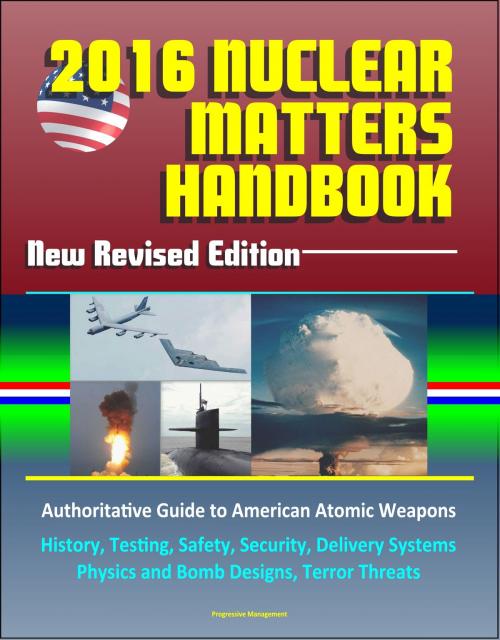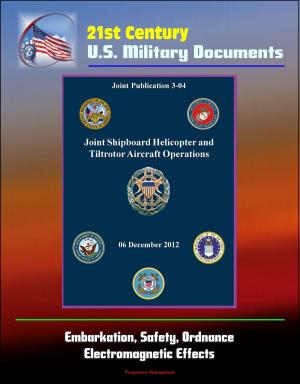2016 Nuclear Matters Handbook: New Revised Edition, Authoritative Guide to American Atomic Weapons, History, Testing, Safety, Security, Delivery Systems, Physics and Bomb Designs, Terror Threats
Nonfiction, History, Military, Nuclear Warfare, Weapons| Author: | Progressive Management | ISBN: | 9781370537594 |
| Publisher: | Progressive Management | Publication: | March 7, 2017 |
| Imprint: | Smashwords Edition | Language: | English |
| Author: | Progressive Management |
| ISBN: | 9781370537594 |
| Publisher: | Progressive Management |
| Publication: | March 7, 2017 |
| Imprint: | Smashwords Edition |
| Language: | English |
Newly expanded and revised for this 2016 professionally-formatted ebook edition, this is an authoritative guide to American nuclear weapons providing a comprehensive description of all facets of the history and current status of the nuclear arsenal, plus background data on bomb design and weapons effects. This book offers an overview of the U.S. nuclear enterprise and how the United States’ safe, secure, and effective nuclear deterrent is maintained.
The Nuclear Matters Handbook is an expanded and revised version of the earlier Nuclear Matters: A Practical Guide ebook. It can be read cover to cover for those who seek to understand the U.S. nuclear program in its entirety, and can also be used as a reference source to look up useful facts and information concerning specific areas. The book is divided into chapters and appendices; the chapters present an overview of the U.S. nuclear program as a whole, while the appendices provide supplementary information on related topics for those less familiar with the subject matter.
Chapter 1 - Nuclear Deterrence — U.S. Policy and Strategy * Chapter 2 - Evolution of the Nuclear Deterrent — A History * Chapter 3 - U.S. Nuclear Forces and Weapons * Chapter 4 - U.S. Nuclear Weapons Infrastructure * Chapter 5 - Stockpile Management, Processes, and Organizations * Chapter 6 - Nuclear Command and Control System * Chapter 7 - Nuclear Surety * Chapter 8 - Countering Nuclear Threats * Chapter 9 - International Nuclear Cooperation * Appendix A - Nuclear Weapons Council and Annual Reports * Appendix B - U.S. Nuclear Weapons Life-Cycle * Appendix C - Basic Nuclear Physics and Weapons Effects * Appendix D - Nuclear and Non-Nuclear Testing * Appendix E - Nuclear Survivability * Appendix F - Nuclear-Related Treaties and International * Appendix G – Classification * Glossary * Acronym List
The U.S. nuclear deterrent, with its unique attributes, is a central element of U.S. national security policy. First, the U.S. nuclear deterrent reduces the probability a nuclear peer or nuclear-armed adversary might engage the United States in a strategic nuclear exchange. Second, U.S. nuclear forces provide a nuclear "umbrella" of protection for many allied nations, reducing their need to develop and field their own nuclear weapons, thereby helping to dissuade nuclear proliferation. Third, the U.S. nuclear arsenal deters nuclear or radiological attack against the United States, its allies, and partners by state-sponsored terrorist organizations or proliferant nations. The U.S. nuclear weapons programs also provide the scientific, technological, and engineering foundation for the U.S. nuclear counterterrorism and counterproliferation programs. For these reasons, it is the policy of the United States to retain and maintain its nuclear deterrent indefinitely until verifiable worldwide nuclear disarmament is achieved.
Defense planning for the employment of nuclear weapons is consistent with national policy and strategic guidance. Planning for the use of nuclear weapons is based upon knowledge of enemy force strength and disposition; the number, yield s, and types of nuclear weapons available; and the status and disposition of friendly forces at the time these weapons are to be employed.
Newly expanded and revised for this 2016 professionally-formatted ebook edition, this is an authoritative guide to American nuclear weapons providing a comprehensive description of all facets of the history and current status of the nuclear arsenal, plus background data on bomb design and weapons effects. This book offers an overview of the U.S. nuclear enterprise and how the United States’ safe, secure, and effective nuclear deterrent is maintained.
The Nuclear Matters Handbook is an expanded and revised version of the earlier Nuclear Matters: A Practical Guide ebook. It can be read cover to cover for those who seek to understand the U.S. nuclear program in its entirety, and can also be used as a reference source to look up useful facts and information concerning specific areas. The book is divided into chapters and appendices; the chapters present an overview of the U.S. nuclear program as a whole, while the appendices provide supplementary information on related topics for those less familiar with the subject matter.
Chapter 1 - Nuclear Deterrence — U.S. Policy and Strategy * Chapter 2 - Evolution of the Nuclear Deterrent — A History * Chapter 3 - U.S. Nuclear Forces and Weapons * Chapter 4 - U.S. Nuclear Weapons Infrastructure * Chapter 5 - Stockpile Management, Processes, and Organizations * Chapter 6 - Nuclear Command and Control System * Chapter 7 - Nuclear Surety * Chapter 8 - Countering Nuclear Threats * Chapter 9 - International Nuclear Cooperation * Appendix A - Nuclear Weapons Council and Annual Reports * Appendix B - U.S. Nuclear Weapons Life-Cycle * Appendix C - Basic Nuclear Physics and Weapons Effects * Appendix D - Nuclear and Non-Nuclear Testing * Appendix E - Nuclear Survivability * Appendix F - Nuclear-Related Treaties and International * Appendix G – Classification * Glossary * Acronym List
The U.S. nuclear deterrent, with its unique attributes, is a central element of U.S. national security policy. First, the U.S. nuclear deterrent reduces the probability a nuclear peer or nuclear-armed adversary might engage the United States in a strategic nuclear exchange. Second, U.S. nuclear forces provide a nuclear "umbrella" of protection for many allied nations, reducing their need to develop and field their own nuclear weapons, thereby helping to dissuade nuclear proliferation. Third, the U.S. nuclear arsenal deters nuclear or radiological attack against the United States, its allies, and partners by state-sponsored terrorist organizations or proliferant nations. The U.S. nuclear weapons programs also provide the scientific, technological, and engineering foundation for the U.S. nuclear counterterrorism and counterproliferation programs. For these reasons, it is the policy of the United States to retain and maintain its nuclear deterrent indefinitely until verifiable worldwide nuclear disarmament is achieved.
Defense planning for the employment of nuclear weapons is consistent with national policy and strategic guidance. Planning for the use of nuclear weapons is based upon knowledge of enemy force strength and disposition; the number, yield s, and types of nuclear weapons available; and the status and disposition of friendly forces at the time these weapons are to be employed.















